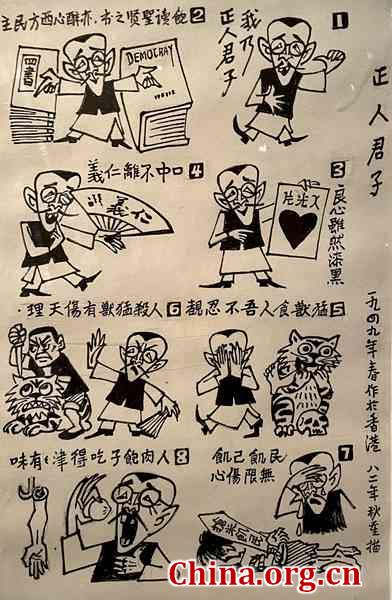Interpreting history through cartoons
- By Jay Ian Birbeck
 0 Comment(s)
0 Comment(s) Print
Print E-mail China.org.cn, January 24, 2022
E-mail China.org.cn, January 24, 2022
Perhaps no cartoonist better captures China's history in the 20th century than Liao Bingxiong (1915-2006). His art evolved alongside China for over 60 years, recording history as it unfolded. From the initial stages of the Chinese People's War of Resistance against Japanese Aggression to the era of reform and opening up, Liao was there to paint it all. As a result, his enormous compilation of cartoons, paintings and woodcuts each offer little insights into more than half a century of Chinese history.

Liao was born into a poor family in Guangzhou in 1915. His father died when he was only 4 years old, and he lost his mother to psychosis at age 6 — traumatic experiences that influenced him for the rest of his career. Liao himself remarked: "Whereas cartoons everywhere are humorous, my work tends to express sadness and anger. I don't create cartoons to relax people. Instead, I make people feel oppressed and shocked."
However, his work also reflected a deep love for his native Guangdong province, which is the focus of the work curated by the Guangzhou Museum of Art in this exhibition. In it, you'll find a rich collection of his depictions of Cantonese local customs and culture, including works from the entirety of his life. Sometimes heartwarming, other times tragic — all Liao's work leaves a lasting impression.
Liao established himself as a painter during the Chinese People's War of Resistance against Japanese Aggression, and his piercing cartoons satirizing the colonial oppressors won him wide recognition throughout Chinese society. In 1944, the legendary Chinese historian Jian Bozan even commissioned him to illustrate his book the "Compendium of Chinese History." Following Japan's defeat, Liao aimed his satirical wit at the Kuomintang, extensively documenting their corruption and abuses of power.
Liao offered his political critiques via a seamless blend of calligraphy and caricatures, resulting in compositions overflowing with energy and meaning. Therefore, even in a spacious exhibition hall, you're bound to feel the impact of historical events through his paintings.
Non-Chinese speakers do not fear. Despite his extensive use of Cantonese idioms and rhymes, Liao was an artist of the people and took great pains to make his work understandable by all, including the illiterate. Moreover, his caricatures ensured that his work was exceedingly salient, even for those who could not understand the writing.

However, Liao is known for much more than just his political cartoons. And the variety of Liao's artistic styles that the Guangzhou Museum of Art has curated makes attending this particular exhibition even more worthwhile. In the 1960s and 1970s, he engaged in stage art design for the Guangdong Puppet Theatrical Company and created many backdrops for their productions. During this time, he increasingly experimented with color and form. The vivid gradients and colors he employed were a stark divergence from his primarily monochromatic cartoons and are today a testament to his mastery over many art styles.
Perhaps the most memorable part of his repertoire comes from later in his career. In the 1980s, as China began to open up to the world, Liao's work turned inward and became more introspective. This period culminated in some of his most remarkable and unsettling creations. A prime example is "Sing Loudly to Amuse Myself," with its vulgar calligraphy surrounding a crazed portrait of Liao seemingly trapped inside an urn. Indeed, shortly before he died, Liao said that this period of his career was his proudest achievement.
His career as a cartoonist ended amid China's rapid social transformation in the late 1990s. Witnessing hamlets and farmland transform into soaring cities, Liao reflected that reality had become even more exaggerated than his imagination. Thus, he gave up drawing cartoons.

Ultimately, the exhibition "Caricatures in the Voice of Southern Guangdong" is a unique reflection on China's recent history by one of the country's greatest cartoonists. The Guangzhou Museum of Art has yet to set an end date for this exhibition, and there's still plenty of time to visit. So, if you're interested in China's history but don't fancy slogging through a history book, make sure to check it out.
Address: 13 Luhu Road, Yuexiu District, Guangzhou, Guangdong province
Opening hours: 9 a.m.-5 p.m. (Entry until 4:30 p.m.)
Closed Mondays (Except for national holidays)
General admission: Free






Go to Forum >>0 Comment(s)